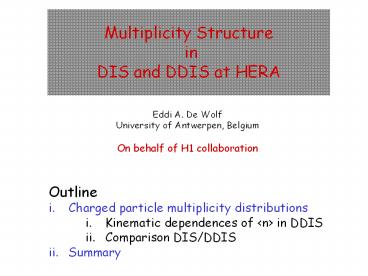Multiplicity Structure in DIS and DDIS at HERA PowerPoint PPT Presentation
Title: Multiplicity Structure in DIS and DDIS at HERA
1
Multiplicity Structure in DIS and DDIS at HERA
- Eddi A. De Wolf
- University of Antwerpen, Belgium
- On behalf of H1 collaboration
- Outline
- Charged particle multiplicity distributions
- Kinematic dependences of ltngt in DDIS
- Comparison DIS/DDIS
- Summary
2
Motivation
- H1 analysis on 94 DDIS data
- Dependence of ltngt on MX
- DDIS W,x,Q2, ß, xIP ,t, MX
- Which ones
- are relevant for multiplicity?
- H1 analysis on 2000 DDIS data
- Large statistics allows more differential study
- W, Q2, ? dependences at fixed MX
- Compare DIS and DDIS
3
Charged particle multiplicity of the hadronic
final state
- The multiplicity distribution P(n)
- Independent emission of single particles Poisson
distribution - Deviations from Poisson reveal correlations and
dynamics - Mean multiplicity ltngt of charged particles
- Particle density in Rapidity Space
- Koba-Nielsen-Olesen (KNO) scaling ?(z)
- energy scaling of the multiplicity distribution
- ?(z) ltngt Pn vs z n/ltngt
4
Diffraction ep -gt eXY
10 of DIS events have a rapidity gap
MX inv. mass of X
5
Models for diffraction
Combine QCD Regge theory resolved IP model
- Proton infinite momentum frame
- Colourless IP is built up of quarks/gluons
- Based on QCD and Regge factorization naïve,
probably incorrect but works! - Needs subleading IR component
6
Models for diffraction contd
- In proton rest frame ? splits into q-qbar
dipole - Model the dipole cross section, for example
- Saturation model Golec-Biernat and Wusthoff (GBW)
Colour dipole approach
7
Data selection DIS and DDIS
- 2000 nominal vertex data 46.65 pb-1
- Data corrected via Bayesian unfolding procedure
- DIS MC DJANGOH 1.3, proton pdf CTEQ5L
- DDIS MC RAPGAP resolved pomeron
- DIS selection
- Good reconstruction of scattered electron
- Kinematic cuts
- 0.05 lt yav lt 0.65
- 5 lt Q2 lt 100 GeV2
- 80 lt W lt 220 GeV
- DDIS selection
- Rapidity gap
- No activity in the forward detectors
- ?max lt 3.3
- Kinematic cuts
- 4 lt MX lt 36 GeV
- xIP lt 0.05
8
Track selection
- Primary vertex fitted tracks
- 15 lt ? lt 165o and pT gt 150 MeV
- Boost to hadronic ?p CMS
use tracks with ? gt 1
acceptance
resolution
9
Multiplicity results
Charged particles with ?gt1 in ?p CMS frame
- Multiplicity distribution and moments
- Q2 dependence of ltngt in DIS/DDIS at fixed W
- ? dependence of ltngt in DDIS at fixed MX
- W dependence of ltngt in DDIS at fixed MX
- Comparison of DIS and DDIS
- Density in Rapidity
- KNO scaling
10
Kinematics Bjorken Plot
DIS W2 Q2/x ymaxln (W/mp)
DDIS
11
Q2 dep. of ltngt in DIS/DDIS at fixed W
- ltngt vs Q2
- DIS/DDIS data (at fixed MX)
- No stat. signif. dependence on Q2
- Weak W- dependence
- Fit ltngt to
- ltngt a b log(Q2)
12
Q2 dep. of dn/d(y-ymax) in DIS at fixed W
- (1/N)dn/d(y-ymax)
- ymax ln(W/m?)
- Weak Q2 dependence
- QCD scaling violations of fragmentation function
DIS ltngt predominantly function of W, not Q2
13
Q2 dep. of dn/d(y-ymax) in DDIS at fixed W
- dn/d(y-ymax)
- ymax ln(W/m?)
- Weak Q2 dependence
- Weak W dependence
- Effect of the gap at lowest W!
DDIS ltngt predominantly function of MX, not Q2
14
? dependence of ltngt
- Intuitive picture expect no ? dependence at
fixed MX (since no Q2 dependence observed)
15
? dependence of ltngt
low ltngt
triplet/anti-triplet
octet/octet
high ltngt
- dipole models
- relative fraction of q and g fragmentation
depends strongly on ? - expect ltngt depends on ?
16
? dep. of ltngt at fixed MX in DDIS
- MX kept fixed
- No obvious ? dependence
DDIS ltngt predominantly function of MX, not Q2 or
? separately
17
W dependence of ltngt?
- Changing W? changing the gap width
- Gap ln(1/xIP)
- Investigate ltngt dependence on xIP
18
W dep. of ltngt at fixed MX in DDIS
All Q2
- At fixed MX change W means change xIP
- Regge factorisation
- diffractive pdfs independent of xIP
- Breaking of Regge factorisation
- In resolved IP model
- pomeron reggeon
19
W dep. of ltngt at fixed MX in DDIS
- Fit ltngt
- ltngt a b log W2
- Regge factorisation breaking expected eg. in
multiple scattering models - Effects predicted to diminish with increasing Q2
( shorter interaction time) not seen here
Factorisation breaking not dependent on Q2
within errors
20
Particle Density in y DIS ? DDIS
- (1/N) dn/d(y-ymax)
- Central region
- particle density similar for DIS and high MX DDIS
DDIS DIS particle density not much different
although MXltlt W
21
Comparison DIS/DDIS KNO scaling
- Negative particles
- ?(z) ltngt Pn
- vs z n/ltngt
- Approximate KNO scaling for DIS and DDIS
- Shape of KNO distribution similar for DIS and
DDIS - Means Correlations very similar
22
Summary
Charged particle multiplicity
- studied for DIS and DDIS in ep at HERA
- ltngt in DIS main dependence only on W, not Q2 or x
separately - ltngt in DDIS main dependence on MX (and a bit on
W), not on Q2 and ? separately - Lack of ? dependence is surprising (q-qbar
q-qbar g) - DIS and DDIS density in rapidity similar at
highest MX - DIS and DDIS approximate KNO scaling same
shape.
Kinematic dependences
Comparison DIS and DDIS

